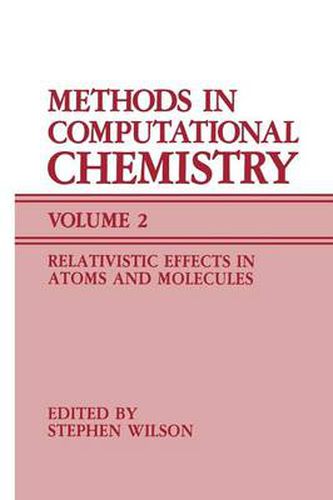Readings Newsletter
Become a Readings Member to make your shopping experience even easier.
Sign in or sign up for free!
You’re not far away from qualifying for FREE standard shipping within Australia
You’ve qualified for FREE standard shipping within Australia
The cart is loading…






This title is printed to order. This book may have been self-published. If so, we cannot guarantee the quality of the content. In the main most books will have gone through the editing process however some may not. We therefore suggest that you be aware of this before ordering this book. If in doubt check either the author or publisher’s details as we are unable to accept any returns unless they are faulty. Please contact us if you have any questions.
Thisvolume isdevotedtomethodsfor thestudyoftheeffectsofrelativity on theelectronicstructure ofatomsand molecules. The accurate descrip- tionofrelativisticeffectsinheavyatomshaslongbeenrecognizedasoneof the central problems ofatomic physics. Contemporary relativistic atomic structure calculations can be performed almost routinely. Recent years have seen agrowinginterestin thestudyoftheeffects ofrelativityon the structureofmolecules. Even for molecularsystemscontainingatoms from thesecondrowoftheperiodictable theenergyassociatedwith relativistic effects is often larger than that arising from electron correlation. For moleculescontainingheavieratoms relativistic effects become increasingly important,andforsystemscontainingveryheavyatomsrelativityisknown todominatemanychemicalproperties. In this volum~, one of the pioneers of relativistic atomic structure calculations,Ian P. Grant,providesadetailedsurveyofthecomputational techniquesemployedincontemporarystudiesoftheeffectsofrelativityon atomicstructure. Thisisanareaofresearchinwhichcalculationscanoften lead to a particularly impressive degreeofagreement between theoryand experiment. Furthermore, theseatomicstudies haveprovided manyofthe foundations of a fully relativistic quantum chemistry. However, the spherical symmetry ofatoms allows significantsimplificationsto bemade in their quantum mechanical treatment, simplifications which are not possibleinstudiesofmolecules. Inparticular, as is wellknown from non- relativistictheoriesofmolecularelectronicstructure,itisalmostobligatory to invoke the algebraic approximation in molecular work and use finite basis set expansions. The problem of describing relativistic effects in molecules is addressed in Chapter2 by Stephen Wilson. This chapter is devotedtoab initiorelativisticmolecularstructurecalculationsinwhichall electrons are explicitly considered. The problem of induding relativistic effects in molecular studies is also addressed in Chapters3 and 4. In Chapter 3, Odd Gropen describes the use of relativistic effective core ix x Preface potentials in calculations on molecular systems involving heavy atoms. This approach can lead to more tractable algorithms than the methods described in Chapter2 and thus significantly extends the range of applications. The use of semiempirical methods has yielded a wealth of informationabouttheinfluenceofrelativityonthechemistryoftheheavier elements. Thisimportantarea is reviewed inChapter4 by Pekka Pyykk6. Finally, inChapter5, Harry M.
$9.00 standard shipping within Australia
FREE standard shipping within Australia for orders over $100.00
Express & International shipping calculated at checkout
Stock availability can be subject to change without notice. We recommend calling the shop or contacting our online team to check availability of low stock items. Please see our Shopping Online page for more details.
This title is printed to order. This book may have been self-published. If so, we cannot guarantee the quality of the content. In the main most books will have gone through the editing process however some may not. We therefore suggest that you be aware of this before ordering this book. If in doubt check either the author or publisher’s details as we are unable to accept any returns unless they are faulty. Please contact us if you have any questions.
Thisvolume isdevotedtomethodsfor thestudyoftheeffectsofrelativity on theelectronicstructure ofatomsand molecules. The accurate descrip- tionofrelativisticeffectsinheavyatomshaslongbeenrecognizedasoneof the central problems ofatomic physics. Contemporary relativistic atomic structure calculations can be performed almost routinely. Recent years have seen agrowinginterestin thestudyoftheeffects ofrelativityon the structureofmolecules. Even for molecularsystemscontainingatoms from thesecondrowoftheperiodictable theenergyassociatedwith relativistic effects is often larger than that arising from electron correlation. For moleculescontainingheavieratoms relativistic effects become increasingly important,andforsystemscontainingveryheavyatomsrelativityisknown todominatemanychemicalproperties. In this volum~, one of the pioneers of relativistic atomic structure calculations,Ian P. Grant,providesadetailedsurveyofthecomputational techniquesemployedincontemporarystudiesoftheeffectsofrelativityon atomicstructure. Thisisanareaofresearchinwhichcalculationscanoften lead to a particularly impressive degreeofagreement between theoryand experiment. Furthermore, theseatomicstudies haveprovided manyofthe foundations of a fully relativistic quantum chemistry. However, the spherical symmetry ofatoms allows significantsimplificationsto bemade in their quantum mechanical treatment, simplifications which are not possibleinstudiesofmolecules. Inparticular, as is wellknown from non- relativistictheoriesofmolecularelectronicstructure,itisalmostobligatory to invoke the algebraic approximation in molecular work and use finite basis set expansions. The problem of describing relativistic effects in molecules is addressed in Chapter2 by Stephen Wilson. This chapter is devotedtoab initiorelativisticmolecularstructurecalculationsinwhichall electrons are explicitly considered. The problem of induding relativistic effects in molecular studies is also addressed in Chapters3 and 4. In Chapter 3, Odd Gropen describes the use of relativistic effective core ix x Preface potentials in calculations on molecular systems involving heavy atoms. This approach can lead to more tractable algorithms than the methods described in Chapter2 and thus significantly extends the range of applications. The use of semiempirical methods has yielded a wealth of informationabouttheinfluenceofrelativityonthechemistryoftheheavier elements. Thisimportantarea is reviewed inChapter4 by Pekka Pyykk6. Finally, inChapter5, Harry M.